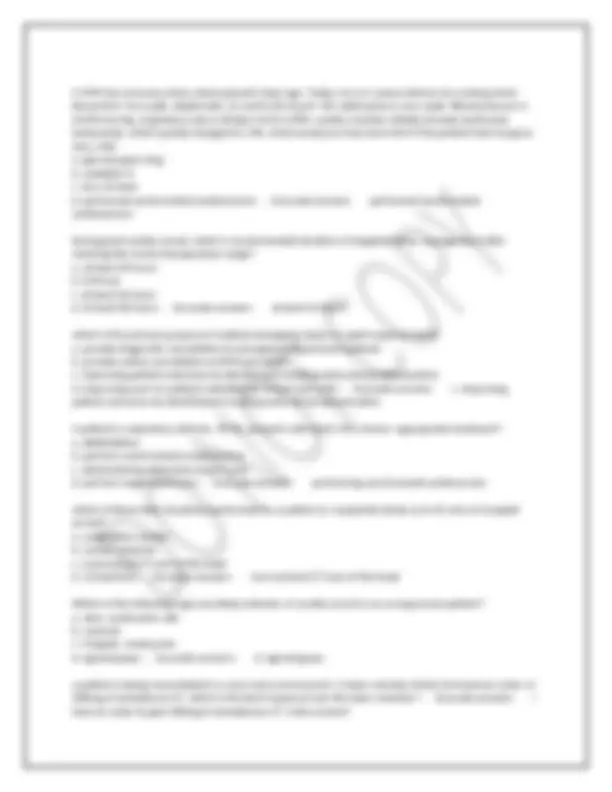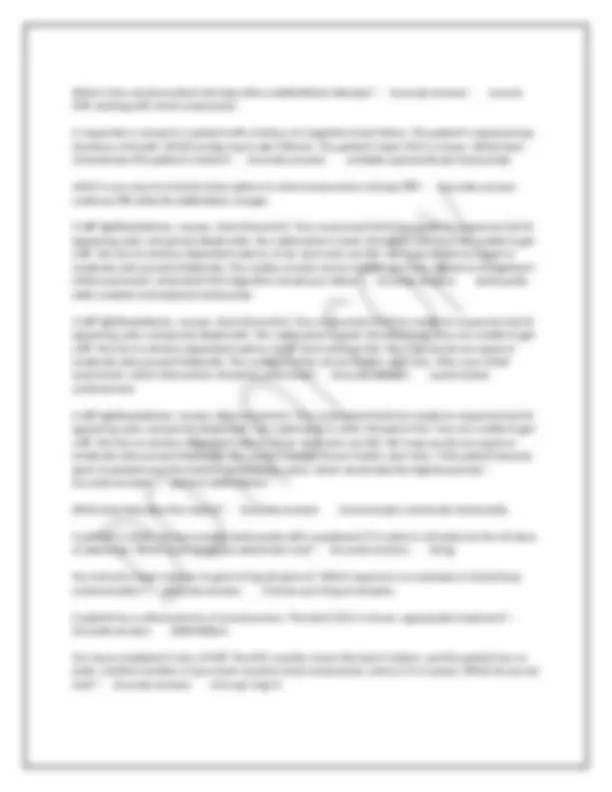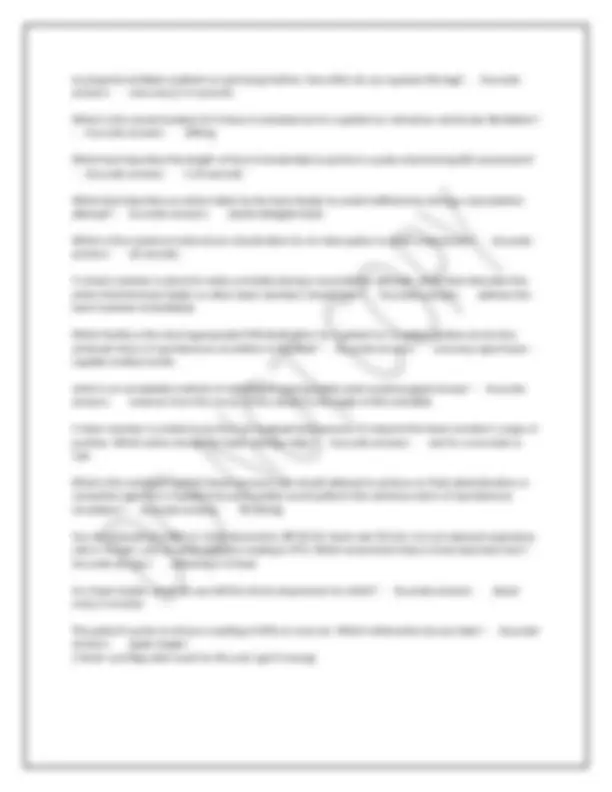





Study with the several resources on Docsity

Earn points by helping other students or get them with a premium plan


Prepare for your exams
Study with the several resources on Docsity

Earn points to download
Earn points by helping other students or get them with a premium plan
Community
Ask the community for help and clear up your study doubts
Discover the best universities in your country according to Docsity users
Free resources
Download our free guides on studying techniques, anxiety management strategies, and thesis advice from Docsity tutors
ACLS POST TEST QUESTIONS WITH 100% ACCURATE ANSWERS
Typology: Exams
1 / 5

This page cannot be seen from the preview
Don't miss anything!




You are caring for a patient with a suspected stroke whose symptoms started 2 hours ago. The CT was normal with no sign of hemorrhage. The patient does not have any contraindications to fibrinolytic therapy. Which treatment is best? a. start fibrinolytic therapy ASAP b. hold fibrinolytic therapy for 24 hours c. order an echo before fibrinolytic administration d. wait for MRI result - Accurate answers a. start fibrinolytic therapy ASAP For STEMI pt, maximum goal time for ED door-to-balloon-inflation time for PCI? a. 150 mins b. 180 mins c. 120 mins d. 90 mins - Accurate answers 90 mins Which is the recommended oral dose of ASA for a pt w/ suspected ACS? a. 81 mg b. 325-650 mg c. 160-325 mg d. 40 mg - Accurate answers 160-325 mg chest compressions during for adult rate - Accurate answers 100-120/min effect of excessive ventilation a. decresed cardiac output b. decreased intrathoracic pressure c. increased perfusion pressure d. increased venous return - Accurate answers decreased cardiac output temperature to achieve targeted temperature management after cardiac arrest - Accurate answers 32-36C 3 mins into cardiac arrest resuscitation attempt, one member of your team inserts an endotracheal tube while another performs chest compressions. Capnography shows a persistent waveform & a PETCO2 of 8mmHg. What is the significance of the finding? a. chest compression may not be effective b. The endotrachael tube is in the esophagus c. the team is ventilating the patient too often d. the patient meets the criteria for termination of efforts - Accurate answers a. chest compression may not be effective Your patient is in cardiac arrest and has been intubated. to assess CPR quality, you should - Accurate answers monitor the patient's PETCO
In addition to clinical assessment, which is the most reliable method to confirm & monitor correct placement of an endotracheal tube? - Accurate answers continous waveform capnography A 45M had coronary artery stents placed 2 days ago. Today he is in severe distress and reporting "crushing" chest discomfort. He is pale, diphoretic, and cool to the touch. His radial pulse is very weak, blood pressure is 64/40, respiratory is 28 bpm/min and O2 set is 89% on room air. - Accurate answers answer has to do with acute coronary syndrome A 45M had coronary artery stents placed 2 days ago. Today he is in severe distress and reporting "crushing" chest discomfort. He is pale, diphoretic, and cool to the touch. His radial pulse is very weak, blood pressure is 64/40, respiratory is 28 bpm/min and O2 set is 89% on room air. When applied, the cardiac monitor initially showed ventricular tachycardia, which then quickly changed to ventricular fibrillation. What do we do? a. chest compression b. vasoactive meds c. vascular access d. advanced airway - Accurate answers a. chest compression A 45M had coronary artery stents placed 2 days ago. Today he is in severe distress and reporting "crushing" chest discomfort. He is pale, diphoretic, and cool to the touch. His radial pulse is very weak, blood pressure is 64/40, respiratory is 28 bpm/min and O2 set is 89% on room air. Despite 2 defib attempt, the patient remains in V-fib. Which drug & dose should be given? a. lidocaine 1 mg/kg b. amiodarone 300mg c. epi 1mg d. atropine 1 mg - Accurate answers epi 1 mg A 45M had coronary artery stents placed 2 days ago. Today he is in severe distress and reporting "crushing" chest discomfort. He is pale, diphoretic, and cool to the touch. His radial pulse is very weak, blood pressure is 64/40, respiratory is 28 bpm/min and O2 set is 89% on room air. despite the drug provided above & continuous CPR, the patient remains in v-fib. which drug should be given next? a. atropine 1mg b. mag sulfate 1g c. amiodarone 300mg d. epi 1 mg - Accurate answers c. amiodarone 300mg A 45M had coronary artery stents placed 2 days ago. Today he is in severe distress and reporting "crushing" chest discomfort. He is pale, diphoretic, and cool to the touch. His radial pulse is very weak, blood pressure is 64/40, respiratory is 28 bpm/min and O2 set is 89% on room air. The patient has returned of spontaneous circulation (ROSC) & is not able to follow commands. Which immediate post- cardiac arrest care intervention do you choose for the patient? a. extubate b. check glucose c. give epi d. initiate targeted temp. management - Accurate answers initiate targeted temperature management (the guideline no longer has post-arrest optimal glucose level)
Which is the recommended next step after a defibrillation attempt? - Accurate answers resume CPR, starting with chest compression A responder is caring for a patient with a history of congestive heart failure. The patient is experiencing shortness of breath, 68/50 mmHg, heart rate 190/min. The patient's lead 2 ECG is shown. Which best characterizes this patient's rhythm? - Accurate answers unstable supraventicular tachycardia which is one way to minimize interruptions in chest compressions during CPR? - Accurate answers continue CPR while the defibrillator charges A 68F lightheadedness, nausea, chest discomfort. Your assessment finds her awake & responsive but ill- appearing, pale, and grossly diaphoretic. Her radial pulse is weak, thready & fast. Your are unable to get a BP. She has no obvious dependent edema, & her neck veins are flat. Her lung sounds are equal w/ moderate rales present bilaterally. The cardiac monitor shows rhythm seen here. Based on the patient's initial assessment, what adult ACLS algorithm should you follow? - Accurate answers tachycardia wide complex (monophasic) tachycardia A 68F lightheadedness, nausea, chest discomfort. Your assessment finds her awake & responsive but ill- appearing, pale, and grossly diaphoretic. Her radial pulse is weak, thready & fast. Your are unable to get a BP. She has no obvious dependent edema, & her neck veins are flat. Her lung sounds are equal w/ moderate rales present bilaterally. The cardiac monitor shows rhythm seen here. After your initial assessment, which intervention should be preformed? - Accurate answers synchronized cardioversiion A 68F lightheadedness, nausea, chest discomfort. Your assessment finds her awake & responsive but ill- appearing, pale, and grossly diaphoretic. Her radial pulse is weak, thready & fast. Your are unable to get a BP. She has no obvious dependent edema, & her neck veins are flat. Her lung sounds are equal w/ moderate rales present bilaterally. The cardiac monitor shows rhythm seen here. If the patient became apnic & pulseless but the rhythm remained the same, which would take the highest priority? - Accurate answers perform defibrillation Which best describes the rhythm? - Accurate answers monomorphic ventricular tachycardia A patient in stable narrow-complex tachycardia with a peripheral IV in place is refractory to the 1st dose of adenosine. Which dose would you administer next? - Accurate answers 12mg You instruct a team member to give 0.5mg atropine IV. Which response is an example of closed-loop communication? - Accurate answers I'll draw up 0.5mg of atropine A patient has a witnessed loss of consciousness. The lead 2 ECG is shown. appropriate treatment? - Accurate answers defibrillation You have completed 2 mins of CPR. The ECG monitor shows the lead 2 rhythm, and the patient has no pulse. Another member of your team resumes chest compression, and an IV is in place. Which do you do next? - Accurate answers Give epi 1mg IV
to properly ventilate a patient w/ perfusing rhythm, how often do you squeeze the bag? - Accurate answers once every 5-6 seconds Which is the recommended 1st IV dose of amiodarone for a patient w/ refractory ventricular fibrillation?